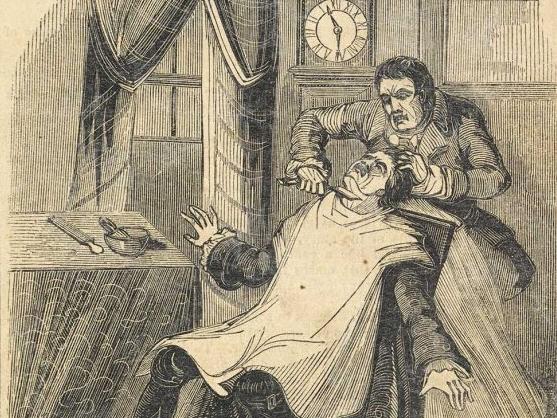Bloody tale of Sweeney Todd inspired by French urban legend
In 1846 writers Thomas Peckett Prest and James Malcolm Rymer hit upon a recipe for a bestseller about a demonic barber who murders his clients and has them baked into pies
Nobody really knows the recipe for a bestseller,
but in 1846 the “penny dreadful” magazine The People’s Periodical And Family Library seemed to have hit on a good one.
It was a serialised story titled The String Of Pearls, which centred on a young woman called Johanna Oakley and her romance with a sailor, which was thwarted by a vengeful barber named Sweeney Todd.
In the story Todd murdered his customers and sent their bodies to be made into pies by his accomplice, baker Margery Lovett.
Although Sweeney was only a supporting character, he quickly became the star. Readers couldn’t get enough of the grisly tale and before it even reached its conclusion
in the penny dreadful it had been turned into a play by the entrepreneurial George Dibden Pitt, who focused on Todd as the main character.
He justified his plagiarism by claiming the play was based on a true story. Audiences loved the remorseless barber and the play was a huge hit. It was revived many times and also adapted to film and TV.

Christopher Bond’s 1973 stage adaptation became the basis for Stephen Sondheim’s 1979 musical Sweeney Todd The Demon Barber Of Fleet Street, a new production of which is now playing at the ICC Sydney, theatre at Darling Harbour, starring Anthony Warlow in the title role.
MORE
Bob Hawke memorial: “Thanks, Bob. Thanks for everything’
The pilots who took on Hitler’s airpower
While the idea of a barber murdering people and having them turned into pies seems a fantastic premise for a story, in the 19th century part of its appeal was that people believed it to have been based on fact.
Centuries before Sweeney first appeared in print there had been stories of a barber in Paris in the 1380s who set up shop next door to a butcher on the Rue des Marmousets in the Ile de la Cite. The butcher’s paté and his meat pies made him the most popular in Paris, even the king was rumoured to be a fan.

One day when the dog of a missing foreign student was found sitting outside the barber’s shop people became suspicious. It was later discovered the barber had been killing foreign students who had come to study religion at Notre Dame and was giving the bodies to the butcher to use in his pies.
The two men were said to have been executed in 1387.
It is most likely an urban legend, because there are no official records to support the story. It was the sort of horror tale that foreigners told about Paris or that people in the French countryside told to warn people about the dangers of the big city.
Another version of the story was mentioned in a 1793 work The Life Of The Late Earl Barrymore, which sets the events in Venice. It tells of a pastry cook near St Mark’s Basilica who makes small meat pies “the flavour and zest of which were uncommonly gratifying”. It is later discovered that he has been stuffing the pies with children who have been going missing and his pie shop is burned to the ground.
In the early 19th century French minister for police Joseph Foucher told the tale of a barber named Becque who had a shop on the Rue de la Harpe and murdered men to rob them and disposed of the bodies by having them minced into pies.

The story made its way into an English magazine Tell-Tale in 1825, authored by Thomas Peckett Prest, who is later believed to have rewritten the story, with help from James Malcolm Rymer, in an English setting for The People’s Periodical And Family Library.
The serialised version was published as the book The String Of Pearls or The Barber Of Fleet Street: A Domestic Romance in 1850.
It was such a hit partly because English rural dwellers told folk tales about people being baked into pies.
In his book Martin Chuzzlewit, Charles Dickens refers to the “dens of any of those preparers of cannibalic pastry, who are represented in many country legends as doing a lively retail business in the metropolis”.
Pitt’s play made it to the screen in 1926 with G.A. Baughan in the title role, and again in 1936 with the aptly named Tod Slaughter as the barber.
Bond’s 1973 play expanded on the character, giving him a backstory and motivation based on revenge for having been sent to Australia by a crooked judge.
Sondheim saw this play and adapted it as a musical. It premiered on Broadway in 1979 with Len Cariou playing Sweeney and Angela Lansbury as Mrs Lovett. Johnny Depp played Todd in a 2007 film version.



